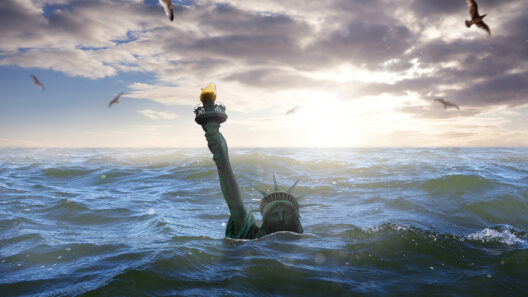Rising sea levels constitute an insidious threat looming over global populations, an impending crisis with far-reaching implications for humanity. As glaciers and polar ice caps steadily melt—a consequence of climate change—coastal communities brace for a daunting future rife with challenges, ranging from displacement to significant economic losses.
This article delves into the potential ramifications of rising sea levels on human society, illuminating the interconnectedness of environmental phenomena and human civilization.
As we embark on this exploration, it becomes increasingly salient to understand the multifaceted risks associated with sea-level rise. The objective is to cultivate an awareness that compels action and fosters an acute understanding of our precarious position amidst these rapid environmental transformations.
Let us embark on this journey together through a landscape shaped by water, contemplating the fate of those who inhabit it.
Understanding the Mechanisms of Sea-Level Rise
Comprehending the process behind rising sea levels is crucial for grasping its impending impact. The phenomenon is primarily driven by two interrelated processes: thermal expansion and glacial melt. As global temperatures ascend, ocean water warms and expands, leading to higher sea levels. Concurrently, the melting of glaciers and ice sheets contributes additional water into the oceans, exacerbating this rise.
These changes are not uniform; various regions will experience different levels of impact. For instance, low-lying coastal areas are at a significantly elevated risk, as are densely populated deltas, where rivers meet the sea. Furthermore, human activities—such as deforestation and urban development—can exacerbate vulnerability, reducing natural buffers against flooding.
Examining the displacement risk
One of the most pressing concerns arising from rising sea levels is the potential for mass displacement. Coastal cities, which house millions, face the ominous forecast of submersion, leading to the forced migration of countless individuals. The Intergovernmental Panel on Climate Change (IPCC) anticipates that by 2050, rising seas may displace over 100 million people globally. This stark figure urges one to contemplate the humanitarian crises that could emerge.
Displacement triggers a cascade of social challenges. Populations uprooted by rising waters may find themselves in precarious circumstances, struggling to rebuild their lives in unfamiliar environments. Furthermore, this forced migration can lead to increased tension in receiving areas, as competition for resources scales up. The plight of those affected by displacement warrants urgent political action and policy development to ameliorate potential crises.
Economic Impacts: A Tidal Wave of Financial Loss
The economic ramifications of rising sea levels are equally alarming. Coastal regions serve as crucial economic hubs, harboring industries like tourism, fishing, and shipping. As these areas face the specter of flooding and erosion, the financial losses could reach staggering billions of dollars.
Tourism, which often thrives in picturesque coastal landscapes, may falter as beaches erode and natural disasters become more frequent. Think of iconic destinations like Miami or Venice—places defined by their relationship with the sea. If these locales become inhospitable, the economic ripples will extend far beyond local borders, affecting global travel patterns and dependent economies.
Moreover, the insurance industry is expected to face increased burdens as properties in flood-prone areas become riskier investments. In many cases, plans for adaptation and mitigation will necessitate substantial funding, prompting governments to allocate significant resources to counteract losses. This potential drain on public funds may divert attention from other pressing social issues.
Adaptation Strategies: Navigating the Rising Tides
In light of the impending challenges posed by rising sea levels, proactive adaptation strategies are essential. Communities must rethink their relationship with coastal ecosystems, embracing innovative measures ranging from sea walls to managed retreat. Investing in sustainable infrastructure—such as elevated buildings and green spaces that can absorb floodwaters—will bolster resilience against rising tides.
Moreover, implementing thorough urban planning that incorporates climate projections can foster long-term stability in vulnerable regions. By prioritizing green and blue infrastructures—such as wetlands and mangroves—coastal communities can bolster their natural defenses, reducing flooding risks while simultaneously enhancing biodiversity.
Public awareness and education are also indispensable components of this adaptation process. By fostering a culture of climate consciousness, individuals can be empowered to advocate for necessary changes within their communities, thus amplifying their voices in regional and national politics. The complexity of rising sea levels should not be construed as insurmountable, but rather as a call to action, urging societies to adapt wisely and equitably.
Conclusion: Charting a Course for a Sustainable Future
Rising sea levels represent a critical juncture in humanity’s trajectory, necessitating a shift in perspective towards environmental stewardship, social justice, and economic sustainability. While the threats posed by climate change may appear daunting, they also offer an opportunity to cultivate innovative solutions and reinforce community engagement. By recognizing the interconnectedness of our ecosystems and societies, we can aspire to chart a course toward resilience that honors both the planet and its inhabitants. As we navigate these tumultuous waters ahead, let us remain motivated by a vision of a sustainable, equitable future—one where humanity triumphs over adversity.








